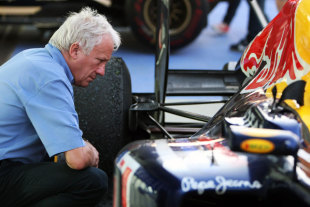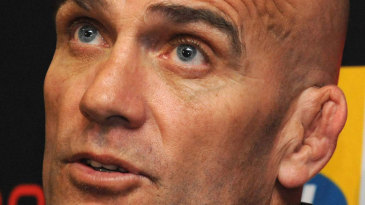- Jean-Charles Piette interview
Why drugs and F1 don't mix

Initially it might seem as though motorsports are an unlikely arena for doping. For despite the existence of a narcotic called 'speed' there doesn't seem to be much in the laboratory that can guarantee a few extra tenths per lap.
But as is always the case in motorsport, it's far more complex than it first appears. While there's nothing out there that obviously relates to added pace in a serum, advantages on the track could come from all manner of areas that could be boosted with the right medication. Drugs both legal and illegal exist that will build muscle strength, aid weight loss, or improve concentration, all areas in which drivers could find an advantage.
In an exclusive interview with FIA F1 medical delegate Jean-Charles Piette, ESPN takes an in-depth look at doping for motorsport, and just why drugs don't form a part of Formula One culture.
"Let's say what could we imagine, what kind of drugs might be potentially useful to improve performance in motor-racing?," Piette begins by asking. "I think we have two aspects - one is in competition, and the other is out of competition. Out of competition, for example, there might be some drugs that help to increase muscle strength. If you have looked at Formula One drivers from the back, as you can see during the briefings, what is striking is that they have such strong neck muscles. To resist, to withstand the G.
"There are some drugs that might reinforce the aptitude and skill to drive in competition," Piette concedes. "On a theoretical basis, we could imagine the potential for such drugs, starting from the benign ones - such as caffeine, for example, or nicotine - to the more serious, such as amphetamines or cocaine. In other sports there have been some positive tests from people, and it's not always clear it's from recreational use.
"If you consider that we will have qualifying in the afternoon, and the gap between two drivers may be a few thousandths of a second, so something that might help - to make you level - perhaps might potentially help. At least, you could imagine that somebody might think so."
But while the drivers might think so, evidence shows that - in Formula One, at least - doping isn't part of the culture. The FIA complies with WADA, the World Anti-Doping Agency, and subjects drivers in various categories to random drug tests which must comply with that organisation's standards.
"Formula One drivers have both in- and out-of-competition testing and they have to fill in - every three months - an Excel file indicating for each day a one-hour slot where they will be," Piette explains. "They can change it, of course, including on the day before. But they may have - and they will have - moments in their life over the course of the year of unscheduled out-of-competition testing. And the main goal is to find out if they are taking drugs like anabolic steroids for their muscles, or perhaps other drugs to lose some weight.
"Now, they also have on a random basis in-competition testing. We have some every year. That will happen once or twice a year, and they won't know in advance, of course. It's just a urine test - at the moment there are no blood tests."
While the drivers are subjected to regular in-competition testing - random doping checks were carried out over the Abu Dhabi Grand Prix weekend - one driver has spoken out to call for more drug testing in Formula One.
Motivated by the recent positive drug test of Australian Moto2 rider Anthony West, who was found with Methylhexaneamine in his system, Mark Webber called for the FIA to do more.
"I've always been championing the idea to do more of it, but the FIA have never really been that strong on it," the Red Bull driver said. "The other drivers have never been super strong on it, so it's never really been a huge issue. You know, with what's at stake, the money involved and all that type of stuff, people do things. It's extremely unlikely, but you never say never."
Piette admitted to being heartened by the Australian's comments.
"I thought about this, and I forwarded his comments yesterday afternoon to Geneva, to the head of the medical administration," he said. "I'm very happy to learn that Mark requires more tests. That's some kind of indication of interest on one side in this case. But there are the costs to consider, and also not to be more boring to drivers. Sometimes in the past they have been unhappy to have an in-competition test, because the guy is working. Sometimes they have to wait one hour, two hours, before getting urine. … And you'd be happier to be with your engineers, checking the data from the car on the track. However, I think there's a good balance. All the F1 drivers are very attentive to these points."
In-competition testing is designed to pick up on drugs that could improve a driver's performance over the shorter-term, perhaps improving his focus or reaction time for the race.
"We have some drugs in medicine that can help you focus attention," Piette reveals. "…Legal and illegal drugs. Some of the former are employed for rare brain disorders where you find you sleep abnormally to help make people alert. This is also used in the Army, by commandos, to stay awake for consecutive days. So that's part of it. And these kinds of drugs are tested for."
Following the Lance Armstrong doping allegations it became public knowledge that some athletes rely on legal medications for pre-existing conditions, and that some athletes attempt to gain an advantage by claiming non-existent conditions so that they can be permitted to take a cocktail of legal medications which will provide a performance-enhancing effect. Keeping track of allowable prescriptions while not precluding disabled athletes from competition is a complex job.
"We rely on WADA, but also we work with the doctors of the International Olympic Committee," Piette explains. "We comply to the WADA rules, to the World Anti-Doping Agency. In the case of medical requirements … there is a therapeutic use committee, which gives its opinion on the problem. … There are really very few problems. And it is very important that they are willing to help people with a disability participate in motor-racing. It's our role as doctors, and the FIA medical department, to help the drivers."

When it comes to the lack of a doping culture in Formula One, there is no clear explanation. The level of personal risk is something that applies to all athletes who chose to dope, and F1 is far from the only sport with random drug testing. But cheating scandals in the paddock tend to be about the machine, and not the man behind the wheel.
The reason for this might be simple: because in motorsport, there is always the wider risk to consider, the harm that a driver can bring not only to himself, but to his fellow competitors, spectators, or marshals in the event of a serious incident.
"It is something different, using drugs in a motor race, and in track and field or soccer," Piette emphasised. "If a soccer player takes some drugs, it is a risk to his health, but not to the team or to the spectators. In a motor race, if a driver takes some drugs, the potential risks are not only to the driver, but also to his colleagues on track, to the spectators, the marshals… They have to consider people beyond themselves."
There is also the on-going uncertainty that makes up a career in F1, particularly in an era populated with fewer sponsors and more short-term driver contracts. Even a simple mistake in medication could prove costly, so drivers err on the side of caution.
"They are highly competitive," Piette asserts. "There are, let's say, four or five top drivers who earn a lot of money. Then there are the middle ranks, then there are the drivers who have to pay to get into the car. They are very aware that their position is something fragile.… They are not sure about getting a seat or not for next year, so I think they take real care about medication."
A key element of the FIA's on-going work to prevent doping in the world of motorsport is e-learning, and the FIA website is home to an e-learning tool which drivers at all ranks can use to measure their awareness of doping in sport. This is especially important for the younger drivers, who will reach the top categories in the coming years.
For more information on the FIA's doping prevention work, click on this link, which is home to the full FIA and WADA doping regulations and standards, as well as the aforementioned e-learning tool.

